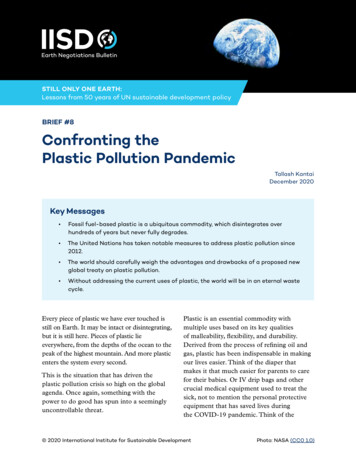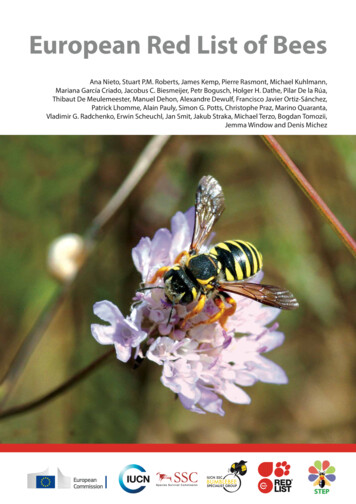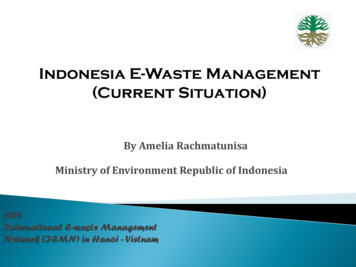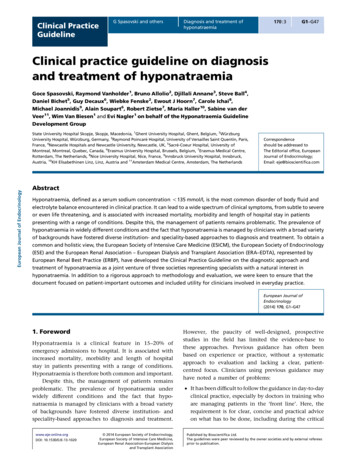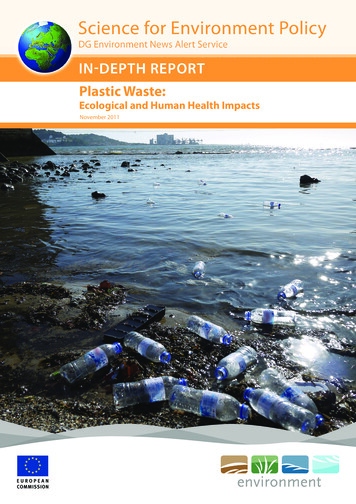
Transcription
Plastic Waste:Ecological and Human Health ImpactsNovember 2011
Plastic Waste: Ecological and Human Health ImpactsContentsExecutive Summary 1Introduction31.0 Plastic Waste: Drivers and Pressures 42.0 State of Plastic Waste in the Environment 83.0 Impacts of Plastics Waste on the Health of Ecosystems164.0 Responses28References37Figures1. World Plastics Production 1950-2008. From Plastic Waste in theEnvironment.2. Continued decoupling of plastic waste and landfill453. Main sources and movement pathways for plastic in themarine environment.64. Proportion of post-consumer waste in EU-27, Norway andSwitzerland according to function, 2008.75. Composition and numbers of marine litter items found onbeaches within OSPAR network.86. Changes in composition of marine items found on beacheswithin OSPAR network97. Algalita Research Centre monitoring108. Litter ( items/ hectare) on the sea bed in the channel (x) andthe gulf of Lion (y) 1998 -2010119. Trends in the average number of marine litter items collectedon reference beaches over three time periods1210. Identity and compostition of plastic debris collected from thestrandline of the Tamar Estuary (UK)1211. Amount of user and industrial plastic in Fulmar stomachs inNetherlands over time 1412. EcoQO performance in North Sea regions 2005-2009 andpreliminary trends. Trend shown by connecting runningaverage 5 year data1513. Trends in EcoQO performance in different regions of theNorth Sea since 2002 (by running 5-year average data)1514. Number and percentage of marine species with documentedentanglement and ingestion records16Science for Environment Policy In-depth Reports Plastic Waste: Ecological and Human Health Impacts November 2011
Plastic Waste: Ecological and Human Health Impacts15. Relationship between BPA concentrations in leachate and percapita GDP of Asian countries16. Illustration of additional effects of plastics in transport ofphenanthrene17. Concentrations of PCBS in beached plastic pellets202223Science for Environment Policy In-depth Reports Plastic Waste: Ecological and Human Health Impacts November 2011
Plastic Waste: Ecological and Human Health ImpactsEXECUTIVE SUMMARYPlastic waste is a growing concern and the drivers behindit look set to continue. Although recently there has beena slight decrease in plastic production, this is unlikely to bemaintained. Plastic is a highly useful material and its applicationsare expected to increase as more new products and plastics aredeveloped to meet demands. The increased use and productionof plastic in developing and emerging countries is a particularconcern, as the sophistication of their waste managementinfrastructure may not be developing at an appropriaterate to deal with their increasing levels of plastic waste.Management of waste in the EU has been improving in termsof recycling and energy recovery, but there is still muchto be done. At the heart of the problem is one of plastic’smost valued properties: its durability. Combined with thethrowaway culture that has grown up around plastic products,this means that we are using materials that are designed tolast, but for short-term purposes.The state of plastic waste is notoriously hard to measure. Itis estimated that in 2008 EU-27, Norway and Switzerlandproduced about 24.9 megatonnes of plastic waste (Mudgalet al., 2011) but its distribution is difficult to ascertain. This isespecially so in the marine environment where the constantmovement of the oceans, both horizontally on the surfaceand vertically within the water column, make it difficultto develop an accurate picture. Since the discovery of theNorthern Pacific Garbage Patch, research has exploredthe gyres as areas of plastic waste accumulation, as wellas beaches and river estuaries. There are a number ofmethods used to survey marine litter and currently thereare initiatives to harmonise these. Several standardisedsurveillance guidelines have been developed, for example,those produced by the Oslo Paris Convention for Protectionof the Marine Environment of the North-East Atlantic (OSPAR)and the United Nations Environmental Programme (UNEP).On land, there are few figures on the level of plastic wasteand there is a need for more information on sources andpossible pathways into the environment. There has beenincreasing concern about the presence of microplastics, whichare generally defined as plastic fragments less than 5mm insize. These are produced either from the weathering of largerplastics or deposited directly as pre-consumer plastic orfrom use in abrasives, such as those used in some cosmetics.Microplastics are particularly difficult to monitor and theymay also have more influential impacts than larger plastics.The impacts of plastic waste on our health and the environmentare only just becoming apparent. Most of our knowledge isaround plastic waste in the marine environment, althoughthere is research that indicates that plastic waste in landfilland in badly managed recycling systems could be havingan impact, mainly from the chemicals contained in plastic.In the marine environment, the most well documented impactsare entanglement and ingestion by wildlife. Other lesserknown effects are the alteration of habitats and the transportof alien species. Perhaps one of the most difficult impactsto fully understand, but also potentially one of the mostconcerning, is the impact of chemicals associated with plasticwaste. There are several chemicals within plastic material itselfthat have been added to give it certain properties such asBisphenol A, phthalates and flame retardants. These all haveknown negative effects on human and animal health, mainlyaffecting the endocrine system. There are also toxic monomers,which have been linked to cancer and reproductive problems.The actual role of plastic waste in causing these health impactsis uncertain. This is partly because it is not clear what level ofexposure is caused by plastic waste, and partly because themechanisms by which the chemicals from plastic may havean impact on humans and animals are not fully established.The most likely pathway is through ingestion, after whichchemicals could bioaccumulate up the food chain, meaningthat those at the top could be exposed to greater levels ofchemicals.Plastic waste also has the ability to attract contaminants, suchas persistent organic pollutants (POPs). This is particularly soin the marine environment since many of these contaminantsare hydrophobic, which means they do not mix or bind withwater. Again, the role of plastic waste in the impact of thesetoxic chemicals is unclear. Plastic could potentially transportthese chemicals to otherwise clean environments and, wheningested by wildlife, plastic could cause the transfer of chemicalsinto the organism’s system. However, in some conditionsplastic could potentially act as a sink for contaminants,making them less available to wildlife, particularly if they areburied on the seafloor. With their large surface area-to-volumeratio, microplastics may have the capacity to make chemicalsmore available to wildlife and the environment in comparisonto larger sized plastics. However, once ingested, microplasticsmay pass through the digestive system more quickly thanlarger plastics, potentially providing less opportunity forchemicals to be absorbed into the circulatory system.Although plastic waste may not always cause detectableharm or death as an isolated factor, when combined withother impacts, such as uncontrolled fishing or oil spills, it maycontribute cumulatively to serious impacts. These sub-lethaleffects are difficult to monitor, but are nonetheless importantto recognise. Research has indicated that some species ordevelopmental stages are more vulnerable to ingestion of plasticwaste and the toxic effects of the chemicals associated with it.Policy responses to plastic waste come in many forms andScience for Environment Policy In-depth Reports Plastic Waste: Ecological and Human Health Impacts November 20111
Plastic Waste: Ecological and Human Health Impactswork on many levels, ranging from beach clean-ups to bans onplastic waste disposal at sea, to targets for waste managementand recycling. Several market-based instruments have beenexplored such as deposit schemes to encourage the returnand multi-use of plastics, and taxation on single-use plasticsthat do not fit into deposit return systems. However there hasbeen little widespread application of these instruments andmore research is needed to maximise their effectiveness andensure they do not have secondary effects other than thoseintended.Plastic waste has the additional complication of spanningmany policy areas, such as marine management, coastalmanagement, waste management and the regulation ofchemicals. This range of responses is necessary for sucha global problem with such local variation, but to ensureplastic waste does not fall through the holes in the net ofresponsibility, there is a need to harmonise efforts and coordinate between different policy areas. A number of reportshave called for better implementation of existing policy. TheMarine Strategy Framework Directive has specified ‘marinelitter’ as one of its descriptors of good environmental statusand four indicators of this have been identified which can beapplied to plastic waste. However, there may also be room forpolicy that is more specifically related to plastic waste, whilestill allowing for its connection to different policy areas.Lastly, there are a number of research gaps that need to beaddressed to provide a stronger evidence-base on whichto develop policy. Some of these are at the detailed levelof impact, such as the actual levels of chemical exposurecaused by plastic waste. Others are more action-orientated,for example, identifying potential hotspots where plasticwaste is problematic, identifying high-risk products that useplastic or identifying wildlife and human groups that are morevulnerable to the impacts of plastic waste. However, the verynature of plastic waste as a fluctuating and mobile issue meansthat science is unlikely to be able to answer all the questions.It may be preferable to take policy action before waiting fora completely clear research picture to emerge so as to avoidthe risk of impacts worsening and becoming more difficult tomanage in the future.Science for Environment Policy In-depth Reports Plastic Waste: Ecological and Human Health Impacts November 20112
Plastic Waste: Ecological and Human Health ImpactsINTRODUCTIONIn the last 60 years, plastic has become a useful and versatilematerial with a wide range of applications. Its uses are likely toincrease with ongoing developments in the plastic industry.In the future, plastic could help address some of the world’smost pressing problems, such as climate change and foodshortages. For example, plastics are used in the manufacture ofrotors for wind turbines and tunnels made from polyethylenecan help crops grow in otherwise unfavourable conditions.As demand for materials with certain qualities increases,the plastics industry will aim to supply them. Meanwhile,increasing plastic production and use in emerging economieslooks set to continue, and waste management infrastructurewill have to develop accordingly.Unfortunately, the properties of plastic that make it so valuablealso make its disposal problematic, such as its durability, lightweight and low cost. In many cases plastics are thrown away afterone use, especially packaging and sheeting, but because theyare durable, they persist in the environment. If plastic reachesthe sea, its low density means it tends to remain on the surface.Increasing attention has been paid to plastic waste bypolicymakers, scientists and the media and probably one ofthe most influential factors was the discovery of the GreatPacific Garbage Patch by Charles Moore in the late 1990s.This is a layer of rubbish floating between California andHawaii that has been estimated to span about 3.43 millionkm2 (the size of Europe). It is mostly plastic and containseverything from large abandoned fishing nets to plasticbottles to tiny particles of plastic (or ‘microplastics’). This typeof mass in the seas can be known as ‘plastic soup’ and thereare concerns that Europe hosts similar patches, in areas suchas the Mediterranean and the North Sea. As such, marinelitter and plastic waste is a priority on the EU policy agenda.been somewhat piecemeal in documenting plastic waste’sdistribution and impacts. To effectively inform policy, thereneeds to be more collation of existing data and greaterharmonisation of research methods. This is also necessary toimplement and monitor policy.This Science for Environment Policy In-depth Report onthe human health and ecological impacts of plastic wastesummarises and collates current research in this area. Using theDrivers Pressures State Impact Response (DPSIR) framework,it highlights major issues and concerns, as well as outliningquestions around existing responses and possible strategiesfor the future.With the global nature of plastic waste, it is difficult to beprecise about the Drivers and Pressures that bear influenceand Section 1 combines the two and concentrates onmeasurement and monitoring. The sections coveringState and Impacts concentrate on human health andecological impacts. Finally, Section 4 deals with Responsesto Plastic Waste and highlights current and future issuesthat need to be addressed, as well as knowledge gapswhere more research is required to inform policy responses.Plastic is still a relatively new material, which means theproblem of plastic waste has only recently been realised, ashas knowledge about its environmental persistence (Barneset al., 2009). Even more recent is the discovery of possiblehealth and environmental effects, such as the impacts of thechemicals contained in plastics. The monitoring of plasticwaste and research into its impacts are still in their infancy,but so far the implications are worrying.The complexity of the issue is enhanced by the global natureof plastic waste and its constant movement, particularly atsea. This makes it difficult to confidently identify sources andscale up impacts from a specific location to create a globalpicture. The content of plastic waste can differ accordingto the location and time of year, while its impacts can varybetween species and human life stages. So far, research hasScience for Environment Policy In-depth Reports Plastic Waste: Ecological and Human Health Impacts November 20113
Plastic Waste: Ecological and Human Health Impacts1.0 PLASTIC WASTE: DRIVERS AND PRESSURESdesire to minimise the use of resources (Kershaw et al., 2011).A life cycle analysis study has indicated that the use of plasticsleads to significantly less energy consumption and emissionsof greenhouse gases than the use of alternative materials(Pilz et al., 2010). In other words, plastic has surpassed othermaterials for certain functions and its comparative advantagesmay be increasing as technology improves.In addition, the increasingly short lifetime of products that useplastic, especially electronic goods, means that more plasticwaste is being produced in today’s upgrade-and-disposeculture. A key example of this is the mobile phone: its plasticcomponents contain several toxic substances (Nnorom &Osibanjo, 2009). Although these substances are not at levelsto cause immediate risk, if quantities increase and end-oflife management is inadequate, such as the open burningoften practised in developing countries, there is potential forenvironmental pollution and human health impacts.Figure 1. World Plastics Production 1950-2008. FromThe CompellingFacts about Plastic, PlasticsEurope (2009), p33.In 2009, around 230 million tonnes of plastic were producedand around 25 per cent of these plastics were used in the EU(Mudgal et al., 2011). This global figure has been increasingby an average rate of 9 per cent since 1950 to a peak of 245million tonnes in 2008, after which there was a slight drop inproduction. The financial recession may be responsible for thisslight decline in plastic production, (PlasticsEurope, 2010 seeFigure 1).About 50 per cent of plastic is used for single-use disposableapplications, such as packaging, agricultural films anddisposable consumer items (Hopewell et al., 2009). Thedrivers for plastic use are its improved physical and chemicalproperties compared to alternatives, its low cost and thepossibility of mass production. Drivers for its reduction lie in aBox 1Production of plastic has levelled off in recent years, however,it is not declining and may well increase in the future asapplications for plastic increase and its use continues to growin developing and emerging economies (Global IndustryAnalysts, 2011). Without appropriate waste management, thiswill lead to increased plastic waste, which will add to the ‘backlog’ of plastic waste already in existence. There is no agreedfigure on the time that plastic takes to degrade, but it could behundreds or thousands of years (Kershaw et al., 2011).Most types of plastic are not biodegradable. Some plastics aredesigned to be biodegradable and can be broken down in acontrolled environment, such as landfill, but it is uncertain ifthis will occur under other conditions, especially in oceanswhere the temperature is colder (Song et al., 2009; O’Brine &Thompson, 2010). Even if plastic does eventually biodegrade,it will temporarily break into smaller fragments, which thenproduce so-called ‘microplastics’. These have a specific andsignificant set of impacts (see sections 3.4, 3.7 and 3.9).Examples of the distribution of plastic waste In 1992, a container ship lost 30,000 rubber ducks off the coast of China. Fifteen years later, some of theseturned up on the shores of the UK (Maggs et al., 2010). In 2005 a piece of plastic found in an albatross stomach bore a serial number traced to a World War II seaplaneshot down in 1944. Computer models re-creating the object’s journey showed it spent a decade the WesternGarbage Patch, just south of Japan, and then drifted 6,000 miles to the Eastern Garbage Patch off the WestCoast of the U.S., where it spun in circles for the next 50 years (Weiss et al., 2006) Van Franeker (2011) estimated that North Sea fulmars annually reshape and redistribute about six tons ofplastic through ingestion of plastic waste.Science for Environment Policy In-depth Reports Plastic Waste: Ecological and Human Health Impacts November 20114
Plastic Waste: Ecological and Human Health Impacts1.1Sources of plastic wastePlastic waste is a global problem, but with regionalvariability. This is particularly true of plastic waste in themarine environment, which can travel long distances, carriedby currents or transported by wildlife, which ingest or becomeentangled in plastic.research vessels, losses from transport, offshore oil and gasplatforms (Sheavly, 2005). A disproportionate amount ofwaste in the marine environment is plastic. Plastics make upan estimated 10 per cent of household waste, most of whichis disposed in landfill (Barnes, 2009; Hopewell et al., 2009).However, 60- 80 per cent of the waste found on beaches,floating on the ocean or on the seabed is plastic (Derraik,2002; Barnes, 2005).Waste management varies fromcountry to country. One of the mostinstrumental EU waste managementregulations is the Landfill Directive(1999), which sets targets for thediversion of biodegradable municipalwaste from landfill, allowing MemberStates to choose their own strategies formeeting these targets. However, thereare no specific targets for diversion ofplastic waste. An EEA review (Herczeget al., 2009) of the Directive in five EUFigure 2. Continued decoupling of plastic waste and landfill. From The Compelling Facts about Plastic, countries and one sub-national areaPlasticsEurope (2009) p11.(Estonia, Finland, the Flemish Region ofBelgium, Germany, Hungary and Italy),The EU’s Waste Framework Directive prioritises prevention indicates that there has generally been a drop in the amountin waste management. To develop effective prevention of waste going to landfill from 1999-2006. Separate data fromstrategies, it is useful for policymakers to know the major a PlasticsEurope report (PlasticsEurope, 2009) indicate that,sources of plastic waste and, if possible, which of these despite a 3 per cent annual growth in the past decade forrepresent the greatest risk. Furthermore, to implement post-consumer plastic waste in EU15, landfill amounts ful increased by only 1.1 per cent per year (see Figure 2), thanksmonitoring of plastic waste is needed to assess the impact to increases in recycling and energy recovery.of policy. An example of this is the EU’s Marine StrategyFramework Directive (MFSD), which has established that Sources of plastic waste vary by region, for example, shippingMember States should take necessary measures to achieve and fisheries are significant contributors in the East Asianor maintain good environmental status of marine waters by Seas region and the southern North Sea (Kershaw et al., 2011),the year 2020. This requires monitoring and therefore the whereas tourism is a major source in the Mediterranean.development of indicators of good environmental status. TheMFSD has outlined 11 descriptors of environmental status, Plastic waste accumulates in certain areas of the sea, such asone of which is marine litter and identified four indicators for gyres, which are large rotating currents, which have lowermarine litter which, by default, also apply to plastic waste in sea levels near their centres. There are five major gyres inthe marine environment (see Box 2).the world: the North Pacific, the South Pacific, the IndianOcean, the North Atlantic and the South Atlantic. These actA significant issue is that, while there is an abundance of data as accumulation zones for marine debris, which is forced intoon debris in the marine environment, there is a comparative the centre where winds and currents are weaker (Moore et al.,shortage of data on plastic waste on land. This is despite 2001).the estimate that 80 per cent of plastic waste in the sea isfrom land-based sources (Sheavly, 2005). The main land- Currents, wave action, and the nature of the continentalbased sources of marine plastic waste include storm water shelf and seafloor also affect the distribution of plastic waste.discharge, combined sewer overflows, tourism related litter, Harbours and estuaries near urban areas tend to attract largeillegal dumping, industrial activities e.g. plastic resin pellets, amounts of plastic waste from recreation and land-basedlosses from accidents and transport, and blowing from landfill sources, while more remote beaches tend to be littered withsites (Allsopp et al., 2006). The ocean-based sources tend to be fishing debris (Derraik, 2002). This is supported by findingscommercial fishing, recreational boaters, merchant/military/ from a study in a conservation area in north-eastern Brazil (IvarScience for Environment Policy In-depth Reports Plastic Waste: Ecological and Human Health Impacts November 20115
Plastic Waste: Ecological and Human Health ImpactsBox 21.2.3.4.MSFD indicators of marine debris to measure good environmental status:Trends in the amount, distribution and composition of marine debris on coastlines.Trends in marine debris in the column and deposited on seafloor.Trends in the amount, distribution and composition of micro particles (mainly microplastics)Trends in the amount and composition of marine debris ingested by wildlife.do Sul et al., 2011) which indicated that 70 per cent of debrison populated beaches comes from local sources, mainlytourism activities, while on unpopulated beaches, non-localsources account for 70 per cent of plastic waste, mainly fromfishing and domestic activities, such as household waste fromrivers and onshore, as well as waste from transiting ships.Although it is important to try and determine sources ofplastic waste for developing and monitoring policy, it shouldbe remembered that the distinction between land-based andsea-based sources is irrelevant for prevention, as all plasticis produced on land. If we are to reduce overall amounts ofplastic waste, the land is where the greatest efforts need tobe made.1.2Categories of plastic wasteCategorisation can help us understand plastic waste andidentify sources. However, most classifications have a purposeand waste is often categorised with a specific goal in mind.For example, a waste classification designed to support arecycling programme would identify commonly recycledplastics (Barnes et al., 2009). Classification can also depend onpolicy, for example, Moore et al. (2011) conducted a study onplastic debris in two Californian rivers that categorised piecesas below or above 4.5mm, because Californian law definesrubbish as being 5mm or greater.One of the most fundamental categorisations is into pre- andpost-consumer plastic waste. Pre-consumer plastic waste isproduced during manufacturing or converting processes,while post-consumer plastic waste is produced after a productis consumed or used. Pre-consumer plastic waste oftenconsists of small pellets that are used to make larger plasticobjects. Many statistics are concerned with post-consumerplastic waste. In 2008, the EU-27, Norway and Switzerlandwere estimated to generate a total of 24.9 megatonnes ofpost-consumer plastic waste (PlasticsEurope, 2009). This wasfurther categorised according to function. (See fig. 4)At sea, plastic waste is often categorised into macro- (over20mm diameter), meso- (5-20mm diameter) and micro(under 5mm diameter) plastics. Very small microplastics arebarely detectable, and for practical purposes, microplasticsare usually defined as those that range from 5mm to 333micrometres (µm). Practically, this is the lower limit because333µm mesh nets (‘Neuston nets’) are commonly used forsampling (Arthur et al., 2009). However, methods, such as‘Fourier Transform infrared spectroscopy’, can detect particlesless than 1.6µm. Macroplastics can be further categorisedaccording to type of object, for example, bottle, bag or lid.1.3Microplastics: sources and categoriesMicroplastics are a significant issue in plastic waste, partlybecause they are more difficult to monitor, and partly becausethey may have greater impacts at a chemical and physicallevel on ecosystems and human health, owing to their sizeand large volume-to-surface area ratio.Figure 3. Main sources and movement pathways for plastic in the marine environment. (from UNEP Year Book, Kershaw et al., 2011)In the ocean as well as on land, plastics tend to fragment intosmaller particles. This can be aided by the action of ultraviolet(UV) radiation, waves and wind. In landfills, leachate acidityand chemicals can break down plastics. In the sea, waterabsorbs and scatters UV so plastics floating near the surfacewill break down more rapidly than those at depth. For thoseon the seabed, breakdown is significantly slower since there isno UV radiation and temperatures are colder.Science for Environment Policy In-depth Reports Plastic Waste: Ecological and Human Health Impacts November 20116
Plastic Waste: Ecological and Human Health ImpactsFigure 4. Proportion of post-consumer waste in EU-27, Norway andSwitzerland according to function, 2008. From Plastic Waste in the Environment, Mudgal et al.(2011)Plastic fragments can also come from the use of plastic particlesas abrasives in‘sandblasting’and exfoliants in cosmetics (Barneset al., 2009; Andrady, 2011), from spillage of pre-productionplastic pellets and powders used for moulding plastic objects,as well as from plastic items deliberately shredded on boardships to conceal plastic waste in food waste (Barnes et al.,2009). These sources are known as primary microplasticsources, whereas secondary microplastics are those formedfrom breakdown of larger plastic material (Arthur et al., 2009).The relative importance of primary and secondary sources ofmicroplastics to the environment is unknown and addressingthis gap could help inform measures to mitigate and preventmicroplastic pollution (Arthur et al., 2009).Andrady (2011) provides a comprehensive review of thedegradation processes of plastics under marine conditionsand the origin of microplastics. The review raises the conceptof nanoplastics. These are engineered plastic nanoparticlesderived from post-consumer waste via degradation. Althoughthey have not been quantified yet the review suggests there islittle doubt that weathering of plastic can produce nanoscaleparticles, which could potentially be easily absorbed byphytoplankton and zooplankton (Andrady, 2011).Another potential secondary source of degradation intomicroplastic is through digestion by wildlife, which alsotransport plastic waste. Van Franeker (2011) suggest thatfulmars (a type of seabird) reduce the size of plastic particlesin their muscular stomach and excrete them back into theenvironment in the form of microplastics. They estimate thatfulmars reshape and redistribute about 630 million plasticparticles every year, representing about six tons in plasticmass.Science for Environment Policy In-depth Reports Plastic Waste: Ecological and Human Health Impacts November 20117
Plastic Waste: Ecological and Human Health Impacts2.0 STATE OF PLASTIC WASTE IN THE ENVIRONMENTAs production and use of plastic has increased over theyears, a large amount of plastic waste has accumulated inthe environment. As a durable material, it is also persistent.Recycling and recovery rates may be improving, but the actualamount of plastic waste produced remains roughly the sameand adds to existing waste.There is little information on the amounts, rates, fate or impactsof plastic waste on land, whereas there has been a major effortto quantify impacts on shorelines and sea (Barnes et al., 2009).If it is not
Plastic Waste: Ecological and Human Health Impacts 1Science for Environment Policy In-depth Reports Plastic Waste: Ecological and Human Health Impacts November 2011 Plastic waste is a growing concern and the drivers behind it look set to continue. Although recently there has been a slight decrease in plastic production, this is unlikely to be




